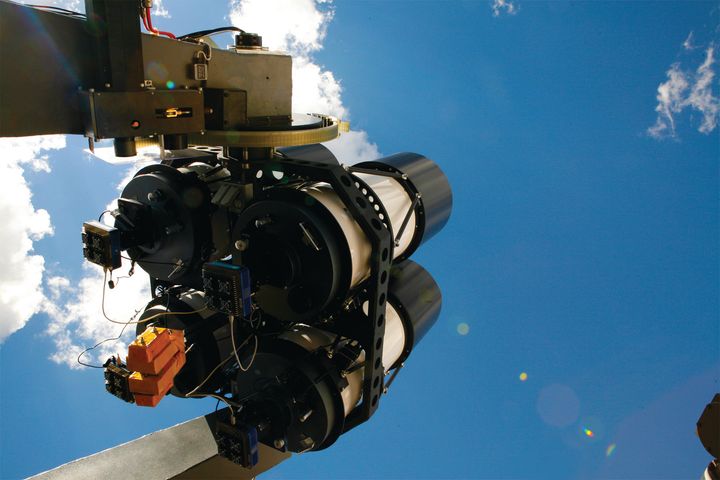
Los Alamos National Laboratory’s robotic thinking telescope system, RAPTOR.
By Spencer Johnson
If you watch the night sky for a while, you’ll start to notice changes. Meteors streak by, the International Space Station glides over in silence, an airplane blinks overhead. Among these celestial transients, less noticeable but far more powerful objects called blazars flash on and off, in brilliant gamma-ray outbursts and flashes of visible light that can last for hours, days, or even weeks.
These flashing beacons telegraph the mind-bending processes inside some of the most energetic events in the universe, as matter swirls in the extreme conditions surrounding a supermassive black hole that is vacuuming up a galaxy’s core. Blazars, a kind of quasar, generate magnetic fields and shock waves that spew out jets of particles from their poles with super-high energies. These particles, traveling at nearly the speed of light, spray radiation across the spectrum, from radio waves to visible light to gamma rays, all aimed directly at Earth. A blazar’s gamma-ray bursts and visible light might take a few billion years to reach us, but they have a story to tell.
The information from these gamma rays and visible light are key to understanding the underlying causes of these spectacular radiation emissions and the tremendously powerful explosions that produce them. That’s what makes these astrophysical events interesting to physicists at Los Alamos National Laboratory—and why, every night in a remote clearing called Fenton Hill high in the Jemez Mountains of central New Mexico, a bank of robotically controlled telescopes tilt their lenses to the sky for another round of observations through digital imaging.
Continue reading below —>
Pictures from a celestial exhibition
Because of blazars’ remoteness from Earth and the challenges of observing them, they remain an obscure, poorly understood, and therefore tantalizing phenomenon for astrophysicists to study. How do you decipher the inner workings of a cosmic cataclysm 3 billion light years away and 3 billion years in the past?
You start by looking at pictures from Fenton Hill. Lots of pictures—about 10,000 each week.
At this tranquil mountain meadow, far from the glare of city lights, the array of telescopes called the Rapid Telescopes for Optical Response, or RAPTOR, has for more than a decade kept an unblinking eye on the night sky, tracking and photographing the visible-light flares from blazars, with powerful computers using machine learning to process the images for analysis.
As RAPTOR makes its rounds across the sky to check on known gamma ray sources and respond to the occasional interesting transient, it has free time every night to photograph blazars. The Lab team processes the images and uses the data in conjunction with gamma ray observations of the same events made by other observatories to further refine the physics models of these fascinating active galaxies.
One task involves sifting through all the images, tossing out the ones that aren’t relevant or usable optically (some are compromised by clouds, wind gusts, focus problems, and so on), keeping the good ones, and determining their light intensity, or magnitude. It provides key information about the processes inside those blazar jets of plasma. Los Alamos has been a leader for years in developing machine-learning computer software to automate those tasks—making it possible to quickly process truly big data. As a graduate student at the Lab, my job has been to develop a new algorithm to streamline that sifting process—and for good reason.
Blazars provide a rich laboratory for studying the interactions among subatomic particles, radiation, and magnetic fields that cannot be conjured here on Earth. Because supermassive black holes produce huge quantities of highly energetic radiation, understanding their behavior as astronomical events helps physicists here at Los Alamos and elsewhere validate computer models coupling radiation and matter. These codes and physical experiments help assure the safety, security, and effectiveness of the U.S. nuclear deterrent, which is the Lab’s core mission.
When the far-reaches of the universe is your laboratory, the limits of learning are boundless.
Spencer Johnson is a post-master’s student in astrophysics working with mentor and Lab scientist Tom Vestrand in the Space and Remote Sensing group at Los Alamos National Laboratory. He plans to enter the doctoral program in high energy physics at the University of Illinois in fall 2017.
